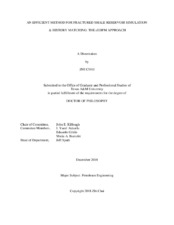| dc.description.abstract | The intricate physics of unconventional reservoir fluid transportation has posed great challenges to traditional simulation approaches. Resources such as shale are usually associated with complex fracture networks generated either naturally as a result of the geo-stress evolution, or artificially during hydraulic fracturing to improve well productivity. In either case, fractures greatly influence the underground fluid transportation, which highlights the importance to accurately simulate the flux with fractures. In this work, a novel discrete fracture model, compartmental EDFM (cEDFM) is developed based on the original EDFM framework. By assuming a linearly distributed pressure near fractures, EDFM can provide a sub-grid resolution that lifts the requirement to perform local refinement. Although efficient, considerable error is reported when applying this method to simulate flow barriers, especially when dominant flux direction is across instead of along the fractures. Therefore, different from the original method, the fracture would split matrix grid blocks when intersecting them in the proposed approach, resulting in a model more similar to an explicit fracture model. The proposed method maintained the high efficiency of the original EDFM, while overcame some of the limitations. The new model is benchmarked for single-phase and multi-phase problems, and the accuracy is evaluated by comparing to multiple reference cases. Results indicate the new model yields much better accuracy even for multi-phase flow simulation with flow barriers.
A major part of the uncertainty for shale reservoirs comes from the distribution and properties of the fracture network. However, explicit fracture models are rarely used in uncertainty quantification due to the high computational cost. The later part of this work explored several
workflows to match the history of reservoirs with fractures. By taking advantage of the efficiency of cEDFM, fractures can be explicitly characterized, and the corresponding uncertainty about the distribution and properties of fractures can be evaluated. No upscaling of the fracture properties is necessary, which is usually a required step in a traditional workflow. A modified two-stage MCMC algorithm as well as the Ensemble Kalman Filter (EnKF) are implemented as the data assimilation algorithms, with the latter preferred for more complex cases with larger parameter space. | en |


